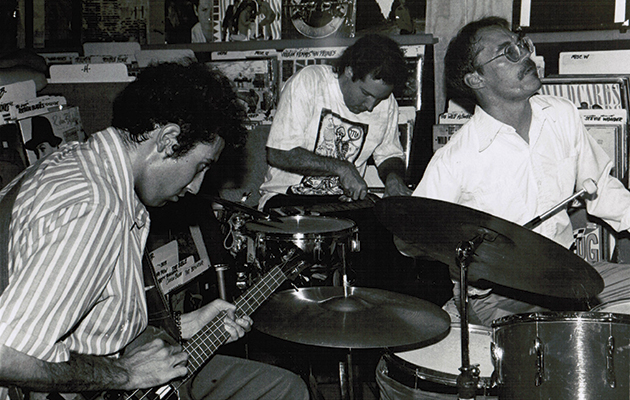They have been many things to many people over the years – exotica merchants; performance anti-artists; mythopoeic poets – but if there’s one thing that defined the long-running underground saga of avant-ethno-psych-rock trio Sun City Girls, it was their unpredictability. Originating from Tempe, Arizona and founded by the Bishop brothers Alan and Richard (who played, predominantly, bass and guitar, respectively), the group’s three-decade tenure ended in 2007 after the passing of drummer Charles Gocher. Across those years, tales of their pranksterism were legion. Live, they’ve been known to improvise a hobos-around-the-campfire skit, or give a slideshow of a trip to Bali; maybe Alan would turn up in his Uncle Jim alter ego and berate the crowd. Once they advertised a gig as “Sun City Girls play John Coltrane’s Live In Seattle” and then proceeded to play an original copy of said Coltrane album over the venue’s PA. They’ve performed a pitch-perfect cover of the soundtrack to Jodorowsky’s El Topo. And so on.
For all their wildness, though, the Sun City Girls held their cards close to their chest, and sometimes they could shock long-term listeners with albums that accessed something spectrally ‘other’. Torch Of The Mystics, one such album, was recorded at a critical juncture for the group. They’d already made some important, if unexpected, connections: circling around the scene that birthed the Meat Puppets, who alongside Butthole Surfers would become one of their few taggable peers in the American underground, they found themselves playing alongside hardcore groups like Black Flag and JFA, whose Placebo imprint released some early Sun City Girls albums. That string of records from across the ’80s pinned the group as, variously, denizens of modern esoterica, a wildly flailing improvised rock troupe, or a multi-headed hydra somewhere between goof-off and stinging political critique, while their self-released Cloaven cassette series gave free reign to their wildest urges.
Torch Of The Mystics would be the last album they recorded before brother Rick moved from Tempe to Seattle. It’s tempting, then, to see it as the culmination of ‘phase one’ of Sun City Girls. It certainly comes across as a clearing of the decks, as soon after, their music became more expansive and unpredictable on gravity-defying sides like Bright Surroundings, Dark Beginnings. It’s also a rare Sun City Girls album for being drawn entirely from the same sessions, recorded in 1988. And it’s structured perfectly, with a vicious, rough-housing Side One – the closest they’ve come to making a perfect rock statement – giving way, on Side Two, to multiple detours into majority-world peregrination.
Torch Of The Mystics opens with the clarion ring of “Blue Mamba”, where a honed riff falls like hammer to anvil, before droning vocals wind out a sinus-cavity hum, Rick Bishop breaking ranks mid-way through for the first of many spiralling guitar anti-solos. “Tarmac 23” has the Girls singing incantations in what sounds like a made-up or channelled language, while they sit on one brooding chord; “Esoterica Of Abyssinia” twists through a slippery, break-neck speed melody from the Orient, mutating at unexpected moments into untethered improvisation. So far, they’ve given us rock music from other planes of there, recorded close to ‘in the red’, the drums clattering away underneath cavernous reverb.
But the following “Space Prophet Dogon” shifts the tone: its descending melody and stately pace are strangely regal. It’s a long, deep exhale, after which things get, in many ways, weirder and weirder. “The Shining Path” is a faithful cover of Bolivian folk song “Llorando Se Fue” – popularised in 1989 by French group Kaoma as “Lambada” – which reclaims the song’s melancholy. “Café Batik” is a spooked organ ceremonial, with Alan Bishop sighing out in a dream-world falsetto; “Radar 1941” is a sea-sick, drunken anti-shanty, “The Vinegar Stroke” a warped, snake-charming rattle that prefigures some of Sir Richard Bishop’s later solo moves.
There are, perhaps, more widescreen Sun City Girls albums – 1996’s 330,003 Crossdressers From Beyond The Rig Veda is a stunning snapshot tour of detourned world music; 1993’s Kaliflower is by turns tightly wound and eerily psychedelic – but Torch Of The Mystics stands as the perfect expression of what Sun City Girls, at the very top of their game, could be. It’s as close to a desert island disc as you’re going to get, and one of the very few albums to survive the ’90s underground with its mystique and magic untarnished. A wholly holistic trip.
Q&A
Alan Bishop
I’d long thought we’d never see reissues of these Sun City Girls albums…
In January, Jimmy at Forced Exposure pointed out that 2015 was the 25th anniversary of the original release, and perhaps a week later David Segal at the Seattle Stranger wrote an article entitled, “When will Sun City Girls reissue Torch Of The Mystics?”, so we decided to do it, although I’d have rather waited for the 37th anniversary or something non-celebratory, but that’s just me.
I’d imagine you re-listened to the album through the process of organising the reissue – how did you respond to hearing this music from your former self?
I heard it last year for the first time in a while and it always sounds good to me. One thing that struck me was that I realised how angelically beautiful Charlie (Gocher)’s voice came through on “Papa Legba”.
What are your memories of recording Torch Of The Mystics?
We were living in a small Tempe apartment in 1988 and I borrowed David Oliphant (of Maybe Mental)’s eight-track Tascam machine and a few mics, asked him some questions about using it, kept my notes at hand, and proceeded to record and mix a ton of material that Summer. We recorded it in a variety of locations, including the median in the middle of Apache Avenue in front of Gammage Auditorium (“Burial In The Sky”). Much of it was recorded live.
INTERVIEW: JON DALE
Uncut: the spiritual home of great rock music.


